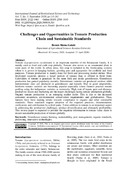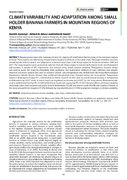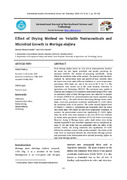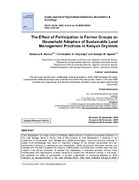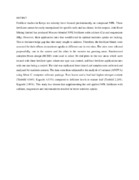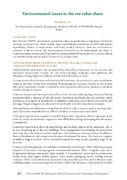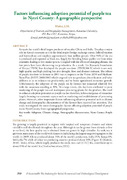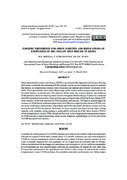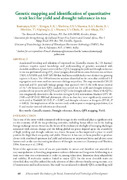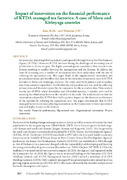Browsing Department of Agricultural Resources and Economics by Title
Now showing items 1-20 of 34
-
Addressing the education and training needs of the tea sector in Kenya: The case of the School of Agriculture and Biotechnology at Karatina University
(2015)In Kenya, personnel working in the tea sector are drawn from various fields of specialization such as general agriculture, horticulture, engineering and economics. There are no special training programmes to train personnel ... -
Assessing the contribution of dolichos bean (Lablab purpureus L. (sweet)) to food security in a changing climate in Kenya
(2022)Lablab pupureus (L.), is a multipurpose drought tolerant legume which is considered as a minor crop in Kenya, hence, it is underutilized. In Kenya there are few known Lablab genotypes for specific environments. Choice of ... -
Challenges and Opportunities in Tomato Production Chain and Sustainable Standards
(International Journal of Horticultural Science and Technology, 2020-04-23)Tomato(Lycopersicon esculentum) is an important member of the Solanaceae family. It is mainly used as food and cash crop globally. Tomato also serves as an ornamental plant in some parts of the ... -
Climate Variability and Adaptation Among Small Holder Banana Farmers in Mountain Regions of Kenya
(Geography, Environment, Sustainability,, 2021-04-01)Banana production is the mainstay industry for majority of small holder farmers living in the mountain regions of Kenya. These regions are affected by climate-related impacts at all levels of the value chain. This paper ... -
A community-based evaluation of population growth and agro-pastoralist resilience in Sub-Saharan drylands
(2019-02)Abstract Human population growth is considered together with climate warming as major driver of change in Sub-Saharan Africa. Research on the implications of increased population densities often utilises community knowledge ... -
Determinants of Agricultural Imports in Sub-Saharan Africa: A Gravity Model
(African Journal of Economic Review, 2021-04)Import dependency on agricultural products in Sub-Saharan Africa (SSA) has been increasing over the last two decades raising a lot of concern on the determinants of agricultural imports and their impact on economic growth. ... -
Determination of the effect of fermentation on the rate of plant nutrient release from plant tissues.
(2022)The use of fermented plant extracts (FPE) as a top dress in crop production is a natural process that can provide plant nutrients and suppress diseases. However, there is scanty information on the use of plant extracts ... -
Effect of Drying Method on Volatile Nutraceuticals and Microbial Growth in Moringa oleifera
(International Journal of Horticultural Science and Technology, 2021)Fresh Moringa oleifera leaves are very rich in phytonutrients, however the leaves are also highly perishable and require processing for increased shelf-life. The method of processing, specifically drying affects the ... -
The Effect of Participation in Farmer Groups on Household Adoption of Sustainable Land Management Practices in Kenyan Drylands
(Asian Journal of Agricultural Extension, Economics & Sociology, 2020-12)Land degradation is a major cause of declining yields and loss of dryland ecosystems resilience in the Lake Baringo Basin in Kenya. One of the solutions to land degradation in drylands is the application of Sustainable ... -
Effects of Blended Fertilizers on Leaf Nutrients Content of Mature Clonal Tea in Kenya. Journal of Experimental Research. Volume 6 (2).
(Enugu State University of Science & Technology, 2018-06)Fertilizer studies in Kenya tea industry have focused predominantly on compound NPK. These fertilizers cannot be easily manipulated for specific soils and tea clones. In this respect, Athi River Mining limited has produced ... -
EFFECTS OF WEATHER ON THRIPS POPULATION DYNAMICS AND ITS IMPLICATIONS ON THE THRIPS PEST MANAGEMENT
(Karatina University, 2008-06-30)Onion thrips, Thrips tabaci Lindeman, is the most destructive insect pest of the onion crop, Allium cepa L. worldwide. Both larvae and adults attack the onion crop at all stages of its growth, resulting in reduction of ... -
Emerging issues in the Tea Industry
(2015) -
Enhancing Tripartite Symbiosis between Soybean, Bradyrhizobia and Arbuscular Mycorrhizal Fungiunder Contrasting Farm Management Practices in Tharaka-Nithi County-Kenya
(Kenyatta University, 2021-05)Organic farming is gaining popularity as agronomically and environmentally sound soil management strategy with the potential to enhance soil microbial diversity and fertility, environmental quality and sustainable crop ... -
Environmental issues in the tea value chain
(2015)The Director EEIPP's presentation pointed out that tea production is important for Kenya’s economy in several ways. These include: direct and indirect contribution to GDP and exports dependency; Source of employment; and, ... -
Factors influencing adoption potential of purple tea in Nyeri County: A geographic perspective
(2015)Kenya is the world’s third largest producer of tea after China and India. Tea plays a major role in Kenya’s economy as it is the third major foreign exchange earner, behind tourism and horticulture and employs approximately ... -
Farm Household Typology Based on Soil Quality and Influenced by Socio-Economic Characteristics and Fertility Management Practices in Eastern Kenya
(2023-04-12)The smallholder farming systems in Sub-Saharan Africa (SSA) are highly diverse and heterogeneous in terms of biophysical and socio-economic characteristics. This study was conducted in upper Eastern Kenya (UEK) to categorize ... -
Farmers' Preference for Onion Varieties and Implications of Knowledge of Iris Yellow Spot Disease in Kenya
(African Crop Science Journal, 2021-03)Thrip transmitted Iris yellow spot disease (IYSD) is an economically important viral disease, affecting bulb onions worldwide. Recommended IYSD resistant varieties are not commonly grown in countries like Kenya, yet ... -
Genetic mapping and identification of quantitative trait loci for yield and drought tolerance in tea
(2015)Accelerated breeding and selection of improved tea (Camellia sinensis (L.) O. Kuntze) cultivars requires sound knowledge and understanding of genetics associated with desirable attributes.Quantitative trait loci (QTL) ... -
ICT and technological development in advancing tea research in Kenya
(2015)Agriculture is the backbone of the Kenyan economy and it is constantly influenced by changes in technology. Because of the rapid development of ICT in the world, each organization or person has to concern their products ... -
Impact of innovation on the financial performance of KTDA managed tea factories: A case of Meru and Kirinyaga counties
(2015)Kenya is a key player in global tea industry and especially through Kenya Tea Development Agency (KTDA). However, KTDA has been facing the challenges of increasing cost of production in the recent past. The higher processing ...


